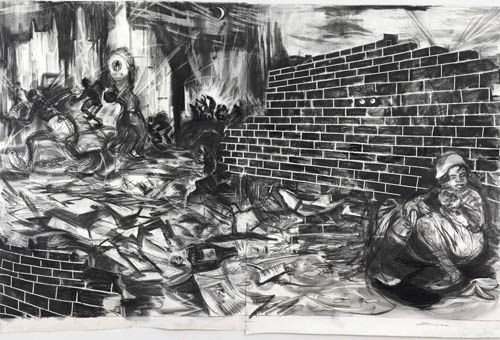Date: THURSDAY, APRIL 21ST 2011 – SATURDAY, JUNE 4TH 2011
Venue: Sikkema Jenkins & Co., 530 West 22nd Street
AFC’s Rating: 8/10 (Will Brand)
Kara Walker makes lynchings look great— formally, that is. It’s a necessary ingredient in the tension of her show Dust Jackets for the Niggerati…, on at Sikkema Jenkins through June 4th. Eschewing her familiar projections and silhouettes, Walker presents a series of twenty-odd large-scale graphite drawings, along with perhaps a dozen text pieces hung in that very 2011 constellation-salon style. The themes are familiar for Walker—race and, uh, race—but where her previous work invited comparisons to literature, here it’s closer to academic painting.
The best works in the show are clearly The moral arc of history… and Pastorale, unabashed history paintings that play a cruel joke on the viewer. Their basic appeal – the size, the composition, the heroic action – makes you admire them too long before recoiling at the enormity of the lynchings and rapes they portray. It’s an apt parallel to the romance and horror of the antebellum South, and requires a certain confidence to attempt: if the paintings aren’t seductive enough visually to provoke that line of engrossment and reflex, they become merely chiding. It’s the difference between lecturing and Socratic questioning, and Walker understands the distinction fully.
Few of the smaller drawings in the show – the genre drawings, as it were – have the same effect. Their draughtsmanship has the pseudo-comic tone that permeates much of Walker’s previous work, but I didn’t like it then and I don’t like it now. Race issues don’t always need gravity, but the suffering-without-pathos of Walker’s weaker pieces doesn’t work. There’s just enough humanity in them to keep them from venturing into pure caricature, but far too little to elicit any real feeling. You look at them, give a certain shocked chuckle, and move on.
The text pieces, taken from accounts of lynchings as well as biographies of early Black actors and singers, are better. Always left incomplete – a reliable tool for interesting the viewer – the phrases Walker clips out are compelling. Further, there’s some real visual appeal to the canvases: I wouldn’t have thought there was a typeface to express “continuing racial tensions in the South are exacerbated by the conflicted appeal of antebellum culture”, but I guess there is, and Walker deserves kudos for finding it.



Comments on this entry are closed.